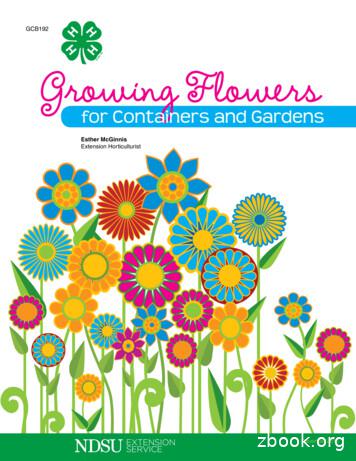FLOWERS AND THEIR PARTS
FLOWERS AND THEIR PARTSFLOWERS ARE SHAPED AND DESIGNED TOATTRACT POLLINATORS. ALL THE COLORS,THE NECTAR REWARDS, THEARRANGEMENTS, AND NUMBER OF PARTSRELATE TO THIS ALL-IMPORTANT PURPOSE
The typical flower consists of four parts, as follows: Sepals are the outermost layer and protect theflower in bud Petals are the next row in and are colorful to attractpollinators Stamens come next; they are the male part of theflower and produce pollen for pollination The pistil or female part is in the center of the flower.The pistil receives pollen and also contains the futureseeds
This cut-away view of the field mustard (Brassica rapa)shows green sepals and yellow petals.
Sepals are usually green. Collectively, they’re known asthe calyx. Here you see the sepals of a trillium. Noticethe white petals just inside
Another example of green sepals is shown here in thispolemonium flower; inside are the purple petals
In poppy flowers like this Eschscholzia californica, thesepals form a cap that pops off when the flower opensas you see in the next image
In a flower like the Muilla maritima, the sepals andpetals have the same color and are only told apart byposition. In this case, they’re referred to as tepals
The Washington lily (Lilium washingtonianum) isanother example of a flower with tepals. Thisphenomenon is common in the lilies and their relatives
Some flowers like those of the anemones have losttheir petals altogether and the sepals substitute in theirplace by being brightly colored.
The petals normally provide color and shape to theflower. Collectively, they’re called the corolla. In thiscolumbine flower, the petals are spurred.
In these manzanita flowers, the petals are partly fusedand urn shaped.
Mustard flowers have widely spreading, bright yellowpetals that attract myriad pollinators
In dogwood flowers (Cornus) the individual flowers aresmall with green petals but there are modified leavescalled bracts that do the attracting of pollinators
Cucurbita petals are partly fused to form an openfunnel.
Orchids like this Cymbidium have the lower petalmodified into a lip with clear-cut nectar guides forpollinators.
In the typical spurge (Euphorbia) flower, the white“petals” are actutally nectar glands that surround acluster of minute flowers
In geraniums, the petals have stripes and blotches thatact as nectar guides to visiting bees.
In sunflowers (Helianthus) and other members of thevast Asteraceae, what seem apparently like petals areactually specialized flowers called ray flowers
In the genus Iris, the prominent sepals have the nectarguides, while the petals stand erect between the sepals
This meadowfoam flower (Limnanthes douglasii) haspetals with a yellow bullseye that also serves as anectar guide
The papillionaceous flowers of this harlequin lupine(Lupinus stiversii) show petals of different colors andshapes
Although most flowers have a fixed number of petals,members of the cactus family like this Opuntia basilarisfeature multiple petals in a spiral arrangement
The minute flowers of oaks (Quercus spp.) areunisexual and wind pollinated. This female flower hasno petals.
The same is true for cattail (Typha) flowers. The leftside shows numerous male flowers; the right tinyfemale flowers. Neither have petals
The California fuchsia (Epilobium canum) has its coloredsepals and petals attached to a long tube called thehypanthium. Many flowers lack hypanthiums.
The two fertile parts of the flower are the stamens andthe pistils. Stamens consist of A stalk called the filament that positions the pollensacs at the end in the right place for the visitingpollinators These pollen sacs comprise the anther, inside ofwhich millions of microscopic pollen grains develop Pollen grains are what need to be transported toanother flower during polliination Anthers have to open before the pollen is availablefor transfer
The stamens of this flower consist of red filaments andyellow anthers
In this flower, the stamens form a pair with the twoanthers nearly touching while the filaments are curved
Anemone flowers feature numerous stamens arrangedlike a wreath around the central green pistils
In snapdragon flowers, the petals are pressed tightlytogether and to reach a nectar reward and thestamens, a strong bumblebee has to force its way in
In this manzanita flower, a tiny pollinator has to enterat the hole in the top. The brown anthers have terminalpores from which the pollen is buzzed out
In milkweed flowers, the stamens form yellow hoodscontaining nectar while the anthers are hidden insidethe center structure
In mustard flowers, the stamens are of two lengths totake advantage of differently sized pollinators passingby
In the hazelnut, the petal-less male flowers are incatkins. When open, the stamens protrude in order todust pollen into the wind
In fuchsia flowers, the stamens protrude beyond thepetals to touch the heads of hovering hummingbirds
The tiny disc flowers of the Asteraceae, here those of asunflower, form cones above the petals, topped by thetwo curled stigmas
In most members of the Malvaceae (mallow family),numerous anthers top the tubular, fused filaments
In the Washington lily (Lilium washingtonianum), theanthers swivel around their attachment to thefilaments
In these petal-less, wind-pollinated grass flowers, thestamens protrude to catch the wind
The female part of the flower—the pistil—sits in thecenter of the flower The pistil consists of three parts— The ovary at the base contains the future seeds orovules The stalk above the ovary—the style—positions thetip of the pistil in the right place for pollinators The stigma at the end of the style, an enlarged knobor arms, traps pollen from passing pollinators
Muilla maritima features a compound pistil with agreen ovary, pale purple style, and 3-lobed stigma
The pistil of a cactus flower has an inferior ovary, asingle style, and a several-lobed stigma
Here you see several separate green pistils in themiddle of this anemone flower. Most flowers have asingle compound pistil
In the arum family Araceae, the pistils are found onpetal-less female flowers. Here the several femaleflowers are enveloped in a large petal-like bract
In this Crassula flower, there are five separate, simplepistils in the center
On squash blossoms, the ovary part of the flower isbelow the other flower parts. Ovary position isimportant in defining families. Here, the ovary isinferior
In this image, you see the whole pistil of a squash witha green ovary, white style, and yellow stigmas
The pistil on this spurge flower is elevated on a stalkwith a 3-lobed green ovary and branches styles
The pistils of the individual disc flowers in theAsteraceae feature an inferior white ovary, a stylehidden from view inside the petals, and a two-lobedstigma at the top
In this wind poppy (Stylomecon heterophylla) you seenumerous stamens around a single compound pistil
The typical flower consists of four parts, as follows: Sepals are the outermost layer and protect the flower in bud Petals are the next row in and are colorful to attract pollinators Stamens come next; they are the male part of the flower and produce pollen for pollination The pistil or female part is in the center of the flower.
edible flowers is important. Use flowers that are grown without pesticides. For best flavor, use flowers at their peak. Introduce new flowers into the diet slowly to be able to pinpoint allergic reactions or stomach upset. Edible flowers also may be preserved in oils or vinegars. 2. (-#)(þ )&)-. . þ / 4 Z aMQ EcMcRG]WeRabWch6gcR]bW ]\ ª .
The early death of flowers is a common cause of quality loss and reduced vase life for cut flowers. Flowers can be divided into several categories in terms of their senescence. Some flowers are extremely long-lived, especially in the daisy and orchid families. Others are short-lived, including many of the bulb crops, like tulip, Iris, and .
Annual flowers are a cheerful addition to the garden and containers. Unlike perennials, annual flowers bloom for a long period and will provide color for most of the summer. Annual flowers live to bloom. You can say they have "flower power"! While you can buy annual flowers from a garden center, growing plants from seed is extra special.
So many uses! Flowers are even eaten! What are the different ways we use flowers in our daily life? Do you know that flowers can be eaten as well? Many flowers are cooked as vegetables. In Uttar Pradesh, Firoza and Nilima enjoy eating a vegetable made of kachnar flowers. In Kerala, Yamini wants her mother to cook her a vegetable made of banana .
DRYING FLOWERS Fall is a good time to begin drying flowers, seedpod and ornamental grasses for later use in indoor arrangements. Steps to follow: 1. Gather the flowers at midday when the humidity is lowest. Pick some buds as well as flowers almost at peak bloom. Avoid fully opened flowers as they do not last long when dried. 2.
Fruits Paired red, orange, or yellow fleshy berries. Flowers Tubular, paired flowers with flaring petals. Flowers form in the spring at the points where leaves meet the stem. Color ranges from white to yellow to pink to rose. Flowers Small, four-parted greenish-yellow flowers form in leaf axi
Dozer Blade Parts, Crawler Loader Parts, Suspension Parts. Section C 2015 Parts Catalog SECTION C DOZER BLADE PARTS, CRAWLER LOADER PARTS, DOZER SUSPENSION PARTS Page BLADE & C-FRAME PARTS CASE C2-C9. DRESSER C18-C19: JOHN DEERE C10-C17; C-FRAMES. CASE C5. JOHN DEERE C13, C15: CRAWLER LOADER PARTS. CASE C1. JOHN DEERE C1:
NO. 19-333 IN THE Supreme Court of the United States ARLENE'S FLOWERS, INC., D/B/A ARLENE'S FLOWERS AND GIFTS, AND BARRONELLE STUTZMAN, Petitioners, v. STATE OF WASHINGTON, Respondent. ARLENE'S FLOWERS, INC., D/B/A ARLENE'S FLOWERS AND GIFTS, AND BARRONELLE STUTZMAN, Petitioners, v. ROBERT INGERSOLL AND CURT FREED, Respondents. On Petition for Writ of Certiorari to the























